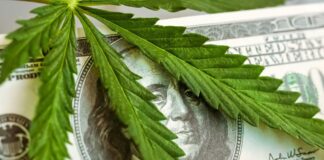
Psychologists tell us that fear is the most powerful motivator we know (and the reason you hate public speaking). One of the most glaring examples of fear-mongering as it relates to the stigmatization of marijuana is the 1936 propaganda film “Reefer Madness.” It effectively capitalized on fear, which has been the impetus for many of the rumors and falsehoods that still surround the cannabis plant.
Most people can name a couple of fear-inducing rumors they’ve heard about weed, but aren’t sure how to separate fact from fiction. As the plant is slowly adopted state-by-state for its medicinal value, it’s crucial to dispel the myths that have tricked people into thinking cannabis is a hazardous drug that will ruin lives with a mere puff of a joint. It’s high time these eight marijuana facts were exposed as the myths they are.
1. You Can Become Addicted to Marijuana
While becoming psychologically dependent on cannabis is possible, the likelihood of developing an addiction is nowhere near as likely as other federally controlled substances, and there are results to back it up. Even when it comes to more socially acceptable substances, such as tobacco or alcohol, cannabis has proven to cause less dependency issues. For instance, a 2011 study showed 8.9% of lifetime cannabis users developed a dependency on marijuana, compared with 22.7% of alcohol users and a whopping 67.5% of tobacco users.
2. Marijuana is a Gateway Drug
Politicians and prohibitionists lobbying against cannabis legalization often use the term “gateway drug” to argue that marijuana use leads to using harder substances. The facts, though, do not support the claim. It’s true that substance abusers might say they turned to marijuana first, but most marijuana users do not end up using cocaine, heroin, or other illicit substances.
The next time someone wants to argue the “gateway” myth, point them in the direction of the Centers for Disease Control and Prevention’s Frequently Asked Questions (FAQ) page. “The majority of people who use marijuana do not go on to use other, ‘harder’ substances,” the U.S.-based national public health institute stated.
Not talked about often enough, is the role cannabis plays as an “exit drug” in helping to combat the opioid crisis by providing a different method of pain relief.
3. Marijuana has No Real Medicinal Value
The medical use of marijuana may seem like a new frontier, but cannabis has been recognized for its therapeutic value since the Chinese herbalist, Emperor Shen Nung, categorized more than 365 medicinal herbs in 2700 BC. He documented the plant as a remedy for aches, pains, and infections.
Throughout the history of cannabis, we’ve seen examples dating back to 4000 BC of how the plant was first used as an anesthetic in an area what is now in the Czech Republic; for nutrition and in ceremonies by the Pazyryk tribes in what is now Siberia; early nomadic Indo-Europeans cultivated the plant for rituals; and cannabis seeds were found in the volcanic ashes of Pompeii.
Now that legalization efforts have started to spread, the early stages of discovery — or rediscovery — signal how the cannabis plant can be useful for food, how hemp fibers can be used for clothing, and yes, how the plant can be used in medicine, too. Cannabis is being used in the fight against opioid abuse and in sports medicine.
4. Marijuana Kills Brain Cells
Over the last century, countless attempts, such as “Reefer Madness” film, have sought to discredit the benefits of cannabis and spread misinformation, including the myth that using marijuana will kill brain cells and make users dumber.
Several studies over the past few decades have suggested that marijuana use as an adolescent can have long-term impairing effects on brain development. Other research has found that the effects on the brains of adult age users are nearly non-existent. A February 2019 study that examined the brain structure of older adults who used cannabis weekly found no widespread impact. “These results suggest that cannabis use likely does not have a widespread impact on overall cortical volume while controlling for age,” the study stated.
5. People Only Smoke Weed to Get High
No matter what misinformed peers might suggest, getting high isn’t the only reason people use marijuana. This myth is easily thwarted by pointing to the growing number of U.S. states adopting medical marijuana laws. People use cannabis everyday for its therapeutic value, whether it be to reduce the frequency of seizures, relieve chronic pain from arthritis, treat glaucoma, or one of the many other ailments this plant might provide treatment for.
If you’ve dug into the chemical makeup of cannabis, you probably know about the psychoactive and intoxicating ingredient of marijuana called THC. It’s the cannabinoid that gives you that high or stoned feeling, but is only one of more than 100 chemical compounds, known as cannabinoids, that are found in the cannabis plant.
You’ve probably also noticed a flurry of health and wellness products containing cannabidiol (CBD). For example, with this non-intoxicating compound, we’ve seen research suggesting that CBD has therapeutic value for psychological disorders such as post-traumatic stress disorder (PTSD) because it targets a part of the central nervous system. As a July 2018 study showed, “CBD can both facilitate the extinction of aversive memories and block their reconsolidation,” and went on to state that both THC and CBD “demonstrate considerable therapeutic potential.”
6. You Can Die From a Weed Overdose
Cannabis use has proven to be significantly less life-threatening than other commonly used substances. An average of 88,000 people in the U.S. die in alcohol-related deaths each year, and cigarettes kill another 480,000, but data on deaths from marijuana is glaringly absent from the 2018 Annual Surveillance Report of Drug-Related Risks and Outcomes from the Centers for Disease Control and Prevention (CDC). Of the 63,632 drug overdose deaths listed in the report, 67% were attributed to prescription and/or illicit opioids.
The report mentions the word “opioid” 375 times, “cocaine” 88 times, “methamphetamines” 59 times, but “marijuana” only 23. On top of that, none of those 23 instances was found under the sections for Nonfatal Overdose Hospitalizations and Emergency Department Visits or Drug Overdose Mortality.
7. Weed is Being Laced with Fentanyl
Fentanyl has become more widely available on the street over the past two decades, and the CDC points to three distinct waves which show the rise of the opioid overdose epidemic.
“The third wave began in 2013, with significant increases in overdose deaths involving synthetic opioids — particularly those involving illicitly-manufactured fentanyl (IMF),” the CDC reported.
In a March 2019 press conference, Kellyanne Conway, President Donald Trump’s senior adviser and opioid crisis czar, proclaimed people were unknowingly buying cannabis laced with fentanyl, but there has been no evidence of dealers using fentanyl or other hard drugs to “cut” weed.
8. Marijuana Leads to Psychosis
Psychosis is a term used for a variety of specific conditions and symptoms where a person can lose touch with reality. Even though “Reefer Madness” was made decades ago, it left a lasting imprint on the minds of generations by capitalizing on the fear of losing control of one’s faculties.
Dr. Adie Wilson-Poe, a neuroscientist and Weedmaps scientific adviser who has extensively studied how cannabinoids interact with the human body, argues that while there may be a link to psychosis, experts can’t say cannabis causes psychosis.
“Undeniably, we know that there is something going on between cannabis and psychosis. But that’s as far as the most well-respected experts in the field are willing to go,” Wilson-Poe said. “We know there is an association. What that association is, we have no idea. We do know that if you already have a vulnerability for psychosis then cannabis can potentially make that worse.”











